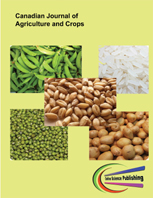The Use of Different Cropping Systems for Pepper (Capsicum Annum) Seed Production in Tropical Rain Forest Soils of Nigeria
DOI:
https://doi.org/10.20448/803.4.2.228.234Keywords:
Double alternate rows, Land equivalent ratio, Scattered pattern, Sole pattern, Strip rows and tropical rainforest soils.Abstract
A cropping system that involved the use of intercropping and planting patterns was used to test the profitability of producing pepper seeds. The triple replicated randomized complete block design experiment was carried out during the wet and dry seasons of 2018 at the Teaching and Research Soils of the Rivers State University Port Harcourt. The planting patterns were: Sole pepper (control), strip rows, double alternate rows and scattered pattern while maize and okra were used as inter crops. During the wet and dry seasons, the control (sole pattern) outperformed the other patterns in fresh pepper fruit yield (6000kg/ha, 5503kg/ha) but not in fruit number and fruit seed yield which were not significantly different from that of strip rows. Also, the strip rows fresh maize cobs yield (9573.3kg/ha, 6133.33kg/ha) and okro pods yield (2453kg/ha, 2470.67kg/ha) in wet and dry seasons respectively were high. With Land equivalent ratio of 2.3 and 1.62 in both seasons, the strip row pattern proved to be more stable, sustainable and profitable. This cropping system (pepper, maize and okra inter crop on strip row pattern) is therefore very profitable since it allows poor resource farmers to harvest different crop produce (maize cobs and okro pods) for use and sale until the maturation, processing and sale/use of the pepper seeds.


